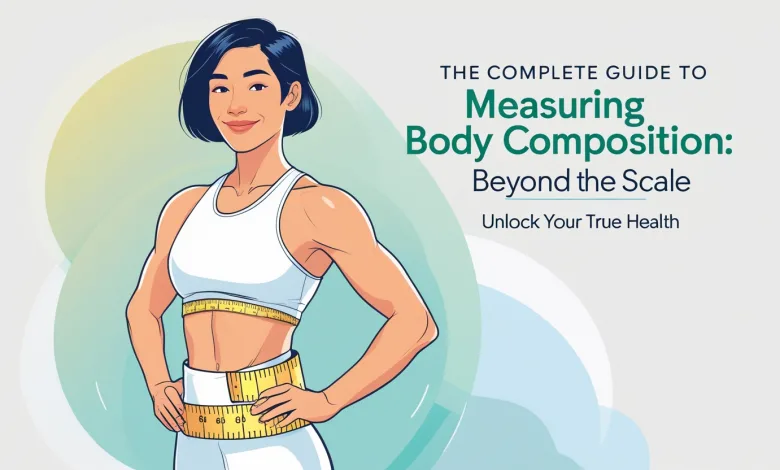The Complete Guide to Measuring Body Composition: Beyond the Scale

Tired of the scale dictating your fitness journey? This comprehensive guide dives into the science of body composition measurement, revealing why the number on your scale is just the tip of the iceberg when it comes to understanding your health and fitness.
Why Your Bathroom Scale Is Lying to You
We’ve all been there — you’ve been hitting the gym consistently, eating clean, and feeling stronger than ever. Yet, when you step on the scale, that stubborn number barely budges. Talk about frustrating! But here’s the thing: your weight is just one small piece of a much larger puzzle.
Traditional scales can’t distinguish between muscle, fat, bone, and water weight. They’re essentially giving you an incomplete picture of what’s happening with your body. It’s like trying to judge a book by weighing it rather than reading the content! The number on your scale doesn’t tell you how much lean muscle you’ve gained or how much fat you’ve lost. And that’s where body composition measurements come into play.
Understanding Body Composition: What Are We Made Of?
Your body isn’t just a lump of “weight” — it’s a complex composition of different tissues, each with unique properties and health implications. When we talk about body composition, we’re referring to the relative proportions of:
- Fat mass (essential and storage fat)
- Lean body mass (muscles, organs, bones, and water)
- Bone mineral content
Knowing these proportions gives you a much clearer picture of your health status than weight alone. For instance, two people weighing exactly the same can have dramatically different body compositions. One might have a high percentage of lean muscle mass and low body fat (think: athlete), while the other might have less muscle and more fat tissue — despite the scale showing identical numbers!
The truth is, body composition is closely linked to metabolic health, disease risk, physical performance, and even longevity. That’s why measuring it accurately matters more than obsessing over pounds and kilograms.
The Limitations of BMI: Why It’s Not the Gold Standard
For decades, Body Mass Index (BMI) has been the go-to method for categorizing people’s weight status. It’s simple — just divide weight in kilograms by height in meters squared. But this simplicity is precisely why it falls short.
BMI was never designed to assess individual health. Belgian mathematician Adolphe Quetelet developed it in the 1830s as a way to study populations, not individuals. Yet somehow, it became the standard measurement tool in doctor’s offices worldwide.
The problems with BMI are numerous:
- It doesn’t distinguish between fat and muscle mass
- It ignores where fat is distributed (visceral vs. subcutaneous)
- It doesn’t account for age, sex, or ethnicity
- It misclassifies many athletes as “overweight” or even “obese”
- It may miss metabolically unhealthy people with normal weight
Consider this: according to BMI charts, many professional athletes would be classified as overweight or obese due to their muscle mass. Meanwhile, someone with low muscle mass and high body fat — a condition known as “skinny fat” or normal weight obesity — might have a perfectly “normal” BMI while facing elevated health risks.
That’s why modern health practitioners are increasingly turning to more sophisticated methods of measuring body composition. Let’s dive into those methods now!
Advanced Methods for Measuring Body Composition
When it comes to accurately assessing what you’re made of, several technologies and techniques stand out. Each has its own set of advantages, limitations, and appropriate use cases.
DEXA Scans: The Current Gold Standard
Dual-Energy X-ray Absorptiometry (DEXA) originally developed to measure bone density, has emerged as the gold standard for body composition analysis. DEXA scans work by passing two X-ray beams with different energy levels through your body. The difference in absorption rates helps distinguish between bone mineral, fat tissue, and lean soft tissue.
The advantages of DEXA are significant:
- Highly accurate (error margin of ~1-2%)
- Provides regional body composition data (where your fat is distributed)
- Measures bone density alongside tissue composition
- Non-invasive and relatively quick (10-20 minutes)
However, DEXA isn’t without drawbacks. It’s expensive (typically $75-250 per scan), exposes you to a small amount of radiation, and requires specialized equipment and technicians. Most people won’t have regular access to DEXA scans unless they’re participating in research studies or have specific medical needs.
As Dr. William Kraemer, professor of kinesiology at the University of Connecticut, notes: “DEXA provides the most comprehensive assessment of body composition currently available in clinical settings, but its cost and limited accessibility make it impractical for regular monitoring for most individuals.”
Hydrostatic Weighing: The Classic Approach
Also known as underwater weighing, this method has been around for decades and involves being completely submerged in water while your weight is measured. Based on Archimedes’ principle, it calculates your body density by comparing your normal weight to your underwater weight, then uses equations to estimate fat percentage.
Hydrostatic weighing is accurate (within 2-3% error) when performed correctly, but it’s not particularly convenient. You need to fully exhale all air from your lungs while underwater, which many people find uncomfortable. It also requires specialized equipment and can’t distinguish between different types of lean tissue.
Air Displacement Plethysmography (Bod Pod)
Think of the Bod Pod as a high-tech egg-shaped chamber that measures how much air your body displaces. Like hydrostatic weighing, it calculates body density but uses air displacement rather than water immersion, making it more comfortable for most people.
The Bod Pod is nearly as accurate as hydrostatic weighing and DEXA (2-3% error margin) and only takes about 5 minutes to complete. However, it’s still relatively expensive and not readily available to most people outside of research institutions and some high-end fitness facilities.
More Accessible Methods for Regular Monitoring
While the methods above provide excellent accuracy, they’re not practical for regular monitoring. Fortunately, several more accessible options can help track your body composition changes over time.
Bioelectrical Impedance Analysis (BIA)
Those sleek bathroom scales that claim to measure body fat? They’re using bioelectrical impedance. BIA works by sending a small, completely imperceptible electrical current through your body. Since fat, muscle, and water conduct electricity differently, the device can estimate your body composition based on resistance patterns.
Modern BIA devices range from simple scales to more sophisticated hand-held or standing units with multiple electrodes. The advantages include:
- Affordable ($30-300 depending on quality)
- Easy to use at home
- Provides immediate results
- Completely non-invasive
The catch? BIA’s accuracy can be affected by numerous factors including hydration status, recent exercise, meal timing, and even ambient temperature. Studies show error margins of 3-8% compared to DEXA.
For best results with BIA:
- Measure at the same time of day (preferably morning)
- Stay consistently hydrated
- Don’t measure after intense exercise
- Focus on trends rather than absolute numbers
Skinfold Calipers: The Classic Approach
Calipers have been used for decades to estimate body fat by measuring the thickness of skin folds at specific sites on the body. A trained professional pinches your skin at several standardized locations (commonly 3-7 sites), measures the fold thickness, and plugs these numbers into equations to estimate body fat percentage.
When performed by an experienced technician, skinfold measurements can have error margins as low as 3-4%. However, results can vary widely based on the technician’s skill level, the specific sites measured, and the equations used. It’s also less accurate for people at the extremes of the body fat spectrum (very lean or obese).
Circumference Measurements: The Military Method
The U.S. Navy developed a method to estimate body fat percentage using just a tape measure and a few simple body measurements. For men, it typically involves measuring neck and waist circumference. For women, neck, waist, and hip measurements are used.
These measurements are then plugged into sex-specific equations to estimate body fat percentage. While not as accurate as the methods above (4-6% error margin), this approach costs virtually nothing, can be done at home, and provides a reasonable estimate for most people.
Emerging Technologies in Body Composition Assessment
The field of body composition assessment continues to evolve with exciting new technologies on the horizon.
3D Body Scanning
Using infrared sensors or multiple cameras, 3D body scanners create detailed models of your external body. While they can’t directly measure internal composition, advanced algorithms can estimate body fat percentage based on your body’s shape and proportions.
Companies like Naked Labs and Styku have developed consumer-friendly versions that provide not just body fat estimates but also detailed circumference measurements and visual representations of how your body changes over time.
Ultrasound Technology
Originally developed for medical imaging, ultrasound is now being adapted for body composition assessment. Portable devices use sound waves to measure the thickness of subcutaneous fat at various sites on the body.
Compared to traditional methods, ultrasound can:
- Distinguish between fat and muscle tissue
- Measure muscle thickness and quality
- Be used for people of all sizes
- Provide site-specific measurements
While not yet mainstream, devices like the BodyMetrix system are making this technology more accessible to fitness professionals and clinics.
How to Choose the Right Method for You
With so many options available, how do you decide which body composition measurement is right for your needs? Consider these factors:
Accuracy Requirements
If you’re a competitive athlete, clinical researcher, or have specific medical concerns, investing in gold-standard methods like DEXA makes sense. For most people monitoring general fitness progress, more accessible methods like quality BIA scales or circumference measurements will suffice.
Budget Considerations
Methods like DEXA and Bod Pod can cost $75-250 per assessment, making them expensive for regular monitoring. BIA scales ($30-300 for a one-time purchase) or skinfold calipers ($20-50) offer more budget-friendly alternatives for tracking changes over time.
Convenience and Accessibility
Consider how often you want to measure your body composition. Home methods allow for frequent monitoring, while lab-based techniques might be better suited for quarterly or bi-annual check-ins.
Consistency Is Key
Whichever method you choose, consistency matters more than absolute accuracy. Using the same method, under similar conditions, tracked over time will reveal meaningful trends in your body composition.
Interpreting Your Results: What the Numbers Really Mean
Once you’ve measured your body composition, what do you do with that information? How do you know if your numbers are “good” or “bad”?
Healthy Body Fat Percentage Ranges
General guidelines for body fat percentage vary by sex and age:
For men:
- Essential fat: 2-5%
- Athletes: 6-13%
- Fitness: 14-17%
- Average: 18-24%
- Obese: 25%+
For women:
- Essential fat: 10-13%
- Athletes: 14-20%
- Fitness: 21-24%
- Average: 25-31%
- Obese: 32%+
However, these ranges aren’t one-size-fits-all. Factors like age, ethnicity, and specific health conditions can affect what’s optimal for you. Working with healthcare providers to establish personalized targets is always best.
Beyond Body Fat: Other Important Metrics
While body fat percentage gets the most attention, other composition metrics matter too:
Lean Mass: Higher levels of muscle mass are associated with better metabolic health, stronger bones, and greater functional capacity as you age.
Visceral Fat: This dangerous fat surrounds your organs and is linked to inflammation and disease risk. Some advanced methods (like DEXA) can distinguish between visceral and subcutaneous fat.
Fat Distribution: Where you store fat matters as much as how much you have. Apple-shaped fat distribution (around the abdomen) carries greater health risks than pear-shaped distribution (hips and thighs).
Using Body Composition to Guide Your Fitness Journey
Body composition measurements are most valuable when used to inform your training and nutrition strategies. Here’s how to apply this knowledge:
Setting Realistic Goals
Understanding your starting point allows you to set achievable targets. For instance, if you’re currently at 30% body fat and want to reach 20%, you now have a specific, measurable goal to work toward.
Remember that healthy body composition changes typically occur gradually:
- Safe fat loss: 0.5-1% of body weight per week
- Muscle gain (for beginners): 1-2 pounds per month
Tracking Progress Beyond the Scale
Regular body composition assessments help you see changes that the scale misses. Gaining a pound of muscle while losing a pound of fat won’t change your weight, but it dramatically improves your body composition and health.
By tracking composition rather than just weight, you can:
- Verify that weight loss is coming from fat, not muscle
- Confirm that your resistance training is effectively building lean mass
- Make informed adjustments to your nutrition and training programs
When to Reassess
How often should you measure body composition? For most people monitoring general fitness progress:
- DEXA or other lab methods: Every 3-6 months
- Home methods (BIA, circumference): Every 2-4 weeks
Measuring too frequently can lead to frustration since visible changes in body composition typically take time. Conversely, waiting too long between measurements might allow ineffective strategies to continue longer than necessary.
FAQs About Body Composition Measurement
Q: Can I accurately measure my body fat at home?
A: Yes, but with limitations. Home methods like quality BIA scales and circumference measurements can provide reasonable estimates and, more importantly, track changes over time. For the most accurate snapshot of your current composition, professional methods like DEXA are superior.
Q: How quickly can body composition change?
A: Meaningful changes in body composition typically occur over weeks and months, not days. Under ideal conditions, beginners might gain 1-2 pounds of muscle per month while losing 1-2 pounds of fat per week (in a caloric deficit). As you become more advanced, these rates tend to slow.
Q: Do I need to know my body composition to be healthy?
A: Not necessarily. Many people maintain excellent health without ever measuring their body composition. However, these measurements provide valuable data that can help optimize nutrition and training programs, especially for those with specific fitness or performance goals.
Q: How accurate are smart scales that measure body fat?
A: Consumer BIA scales typically have error margins of 3-8% compared to gold-standard methods. They’re more valuable for tracking changes over time than for determining your exact body fat percentage on any given day.
Q: Can children and teens safely have their body composition measured?
A: Yes, but with important caveats. Body composition measurement in youth should be conducted sensitively, focusing on health rather than appearance. Methods that don’t emphasize “fat” (like the Bod Pod) may be preferable. Always consult with pediatric healthcare providers before implementing formal body composition testing for children.
The Final Analysis: A Balanced Approach to Body Composition
Understanding your body composition can be incredibly empowering. It shifts the focus from arbitrary weight goals to meaningful health and fitness metrics. However, it’s important to maintain perspective.
Body composition is just one aspect of health and fitness. It doesn’t measure cardiovascular endurance, strength, flexibility, balance, coordination, or mental wellbeing. It doesn’t tell you if you’re happy, energetic, or capable of doing the activities you love.
The most balanced approach is to use body composition data as one tool among many to inform your health decisions. Combine it with other metrics like energy levels, performance measures, bloodwork, and most importantly, how you feel.
Remember that “ideal” body composition varies widely based on genetics, age, health status, and personal goals. What’s optimal for a 25-year-old competitive athlete differs dramatically from what’s healthy for a 65-year-old focusing on longevity.
By understanding the various measurement methods and their appropriate applications, you can make informed choices about tracking your body composition in ways that support — rather than detract from — your overall health and wellness journey. After all, the goal isn’t just to change your body’s numbers, but to enhance your quality of life.






